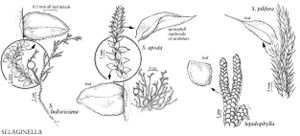Difference between revisions of "Selaginella lepidophylla"
in Martius et al.,Fl. Bras. 1(2): 126. 1840.
FNA>Volume Importer |
FNA>Volume Importer |
||
| Line 20: | Line 20: | ||
}}<!-- | }}<!-- | ||
| − | --><span class="statement" id="st- | + | --><span class="statement" id="st-undefined" data-properties=""><b>Plants </b>terrestrial or on rock, forming rosettes. <b>Main</b> (central) stem spirally compact, branched, branches 2–3-forked, prostrate, flat when moist, curling inward when dry (ball-like), not articulate, weakly puberulent. <b>Rhizophores</b> borne on upperside of stems, restricted to basal part of rosette, 0.3–0.5 mm diam. <b>Leaves</b> thick and stiff. <b>Lateral</b> leaves yellow to reddish on abaxial surface, green on adaxial surface, overlapping, ascending, deltate to deltate-ovate, 2–2.2 X (1–)1.7–1.8 mm; base nearly cordate, pubescent; margins transparent, ciliate toward base, dentate to ciliate toward apex; apex rounded. <b>Median</b> leaves broadly ovate, 1.5–1.7 × 1.4–1.5 mm; base nearly cordate to truncate, pubescent; margins transparent, ciliate toward base, dentate to ciliate toward apex; apex abruptly acuminate (short-cuspidate) to obtuse. <b>Strobili</b> solitary, 3–12 mm; sporophylls monomorphic, deltate-ovate, slightly keeled, keel not dentate, base pubescent, margins transparent, short-ciliate at base, denticulate toward apex, apex acuminate to acute.</span><!-- |
-->{{Treatment/Body | -->{{Treatment/Body | ||
| Line 50: | Line 50: | ||
|publication year=1840 | |publication year=1840 | ||
|special status= | |special status= | ||
| − | |source xml=https://jpend@bitbucket.org/aafc-mbb/fna- | + | |source xml=https://jpend@bitbucket.org/aafc-mbb/fna-data-curation.git/src/9216fc802291cd3df363fd52122300479582ede7/coarse_grained_fna_xml/V2/V2_237.xml |
|genus=Selaginella | |genus=Selaginella | ||
|subgenus=Selaginella subg. Stachygynandrum | |subgenus=Selaginella subg. Stachygynandrum | ||
|species=Selaginella lepidophylla | |species=Selaginella lepidophylla | ||
| − | |||
| − | |||
| − | |||
| − | |||
| − | |||
| − | |||
| − | |||
| − | |||
| − | |||
| − | |||
| − | |||
| − | |||
| − | |||
| − | |||
| − | |||
| − | |||
| − | |||
| − | |||
| − | |||
| − | |||
| − | |||
| − | |||
| − | |||
| − | |||
| − | |||
| − | |||
| − | |||
| − | |||
| − | |||
| − | |||
| − | |||
}}<!-- | }}<!-- | ||
-->[[Category:Treatment]][[Category:Selaginella subg. Stachygynandrum]] | -->[[Category:Treatment]][[Category:Selaginella subg. Stachygynandrum]] | ||
Revision as of 13:14, 27 July 2019
Plants terrestrial or on rock, forming rosettes. Main (central) stem spirally compact, branched, branches 2–3-forked, prostrate, flat when moist, curling inward when dry (ball-like), not articulate, weakly puberulent. Rhizophores borne on upperside of stems, restricted to basal part of rosette, 0.3–0.5 mm diam. Leaves thick and stiff. Lateral leaves yellow to reddish on abaxial surface, green on adaxial surface, overlapping, ascending, deltate to deltate-ovate, 2–2.2 X (1–)1.7–1.8 mm; base nearly cordate, pubescent; margins transparent, ciliate toward base, dentate to ciliate toward apex; apex rounded. Median leaves broadly ovate, 1.5–1.7 × 1.4–1.5 mm; base nearly cordate to truncate, pubescent; margins transparent, ciliate toward base, dentate to ciliate toward apex; apex abruptly acuminate (short-cuspidate) to obtuse. Strobili solitary, 3–12 mm; sporophylls monomorphic, deltate-ovate, slightly keeled, keel not dentate, base pubescent, margins transparent, short-ciliate at base, denticulate toward apex, apex acuminate to acute.
Habitat: Dry places on rocky soil or on limestone talus
Elevation: 900–2000 m
Distribution

N.Mex., Tex., Mexico.
Discussion
Selaginella lepidophylla is sold as a commonly grown house plant and is cultivated in greenhouses. When dry, lateral branches of desiccated plants curl inward; upon rehydration, they uncurl and resume normal growth, even after years of being dry. Among the species in the flora, it is allied to S. pilifera.
Of conservation concern.
Selected References
None.
